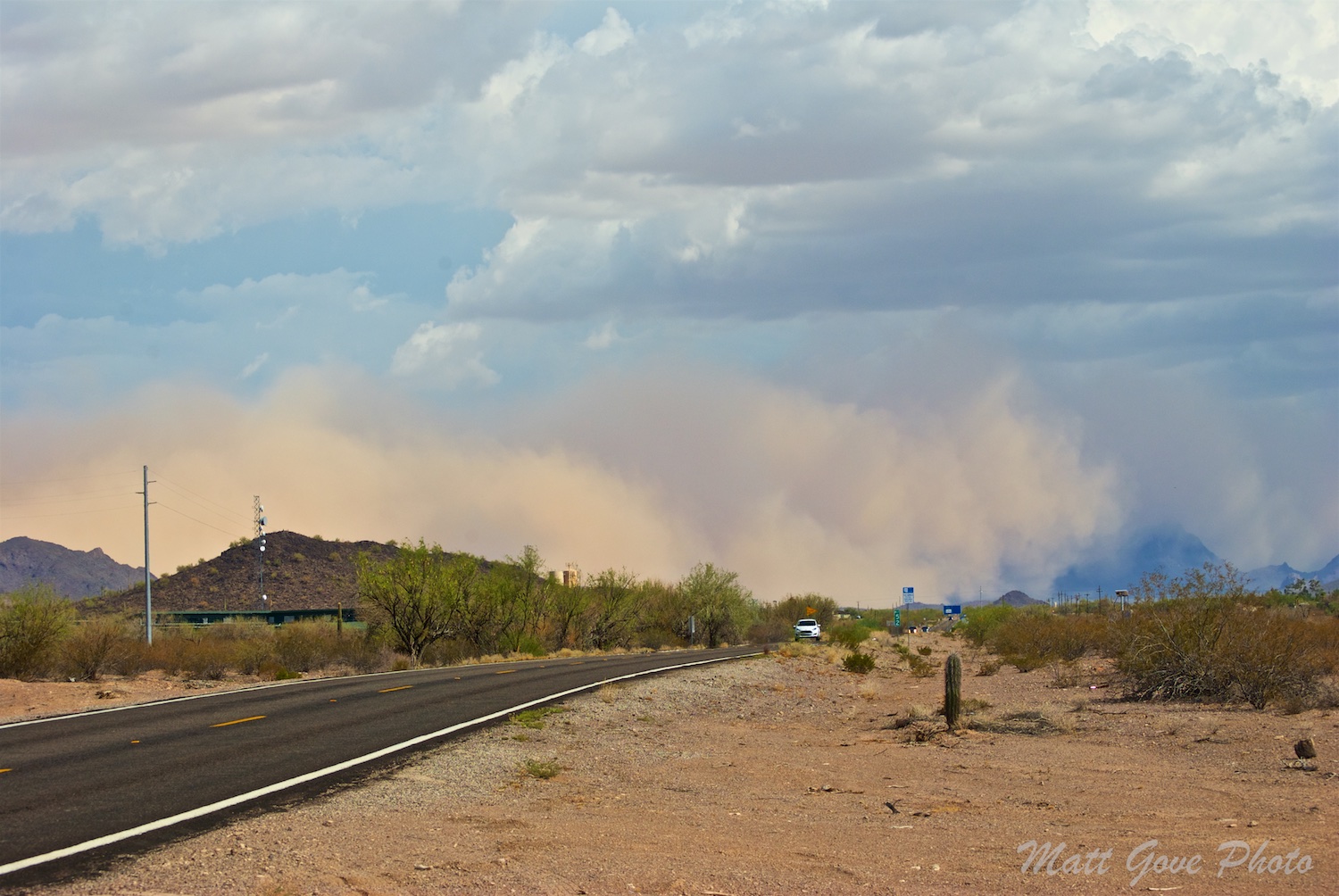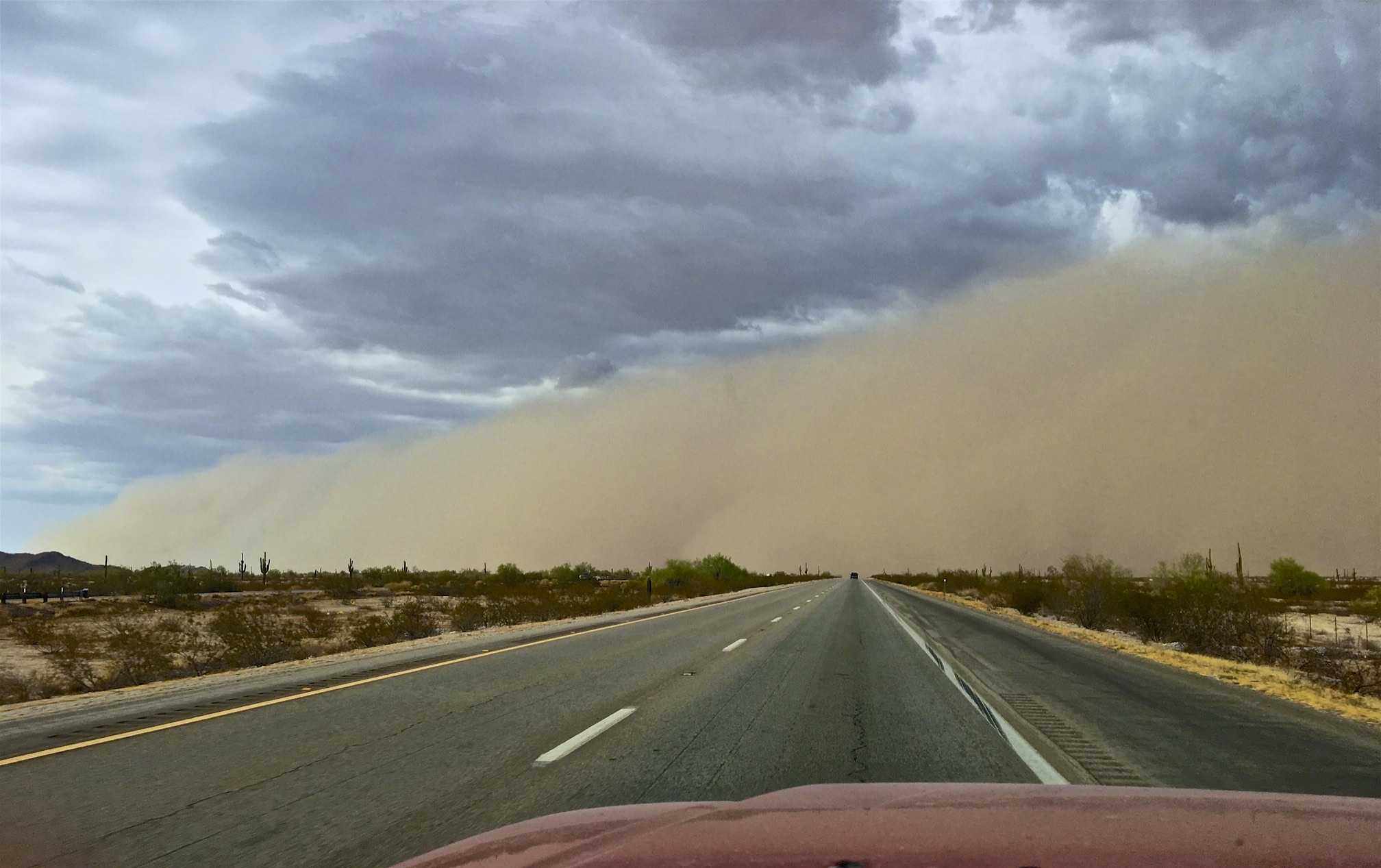It is one of the most unforgettable sights you’ll ever see rolling across the deserts. From afar, it looks just like a low cloud formation at the base of a thunderstorm, but as you get closer, the area between the ground and the base of the thunderstorm begins to turn a tannish brown color, and before you know it, you’re looking straight up a mile-plus high wall of dust.
This phenomenon is called a haboob, which is a very specific type of intense dust storm that forms on strong outflow boundaries or gust fronts of thunderstorm. They are often caused by air rushing out of a thunderstorm during a microburst or when the storm’s updraft collapses. They can be up to 100 miles long, 2 miles high, and frequently pack winds in excess of 50 mph, which can reduce visibilities to near zero in an instant.
The term haboob is an Arabic word that originated in the Sahara regions of northern Africa, but is an official meteorological term that has used throughout the world for almost a century. A haboob is a very specific type of dust storm, so all haboobs are dust storms, but not all dust storms are haboobs. If you’re still confused and would prefer to just call it a dust storm, that’s perfectly fine.
This past Monday, I was down at the Organ Pipe Cactus National Monument to view some wildlife and explore some of the ranching history at the monument. I knew it was going to be an active monsoon day, but I never would have guessed that it would have turned into such an incredible afternoon of storm chasing almost by accident. We “chased” 2 dust storms, including the one haboob, and numerous thunderstorms from the Mexican border all the way back to Phoenix.

Monsoon thunderstorms begin to bubble up along the US-Mexico border east of Lukeville, AZ
Shortly before leaving the Organ Pipe Cactus National Monument, skies began darkening to the east as the monsoon storms started initiating over the nearby mountains. I wanted to start heading north in order to stay ahead of the storms, as that would offer the best photo opportunities.
Sitting just outside the northern boundary of the national monument is the town of Why. It’s a small and mostly forgotten town whose inhabitants today are mostly US Customs officers and Border Patrol agents. As I passed through town, I looked in the mirror and it looked like the mountains to the south were disappearing into thin air. The first dust storm of the day was here.

First dust storm of the day swallows the nearby mountains as it heads for the town of Why, AZ
I don’t think this first dust storm qualified as a haboob because it was a long way from the thunderstorms that had popped up and was unlikely that it was traveling on an outflow boundary or gust front. Second, it lacked the “wall of dust” property that defines haboobs, but passing over the mountains may have disrupted the appearance of being a wall of dust.
The 50 mile run from Why back to Gila Bend was uneventful. Back in Gila Bend, a quick look at the  radar show that nearly the entire Phoenix metro was under a Severe Thunderstorm Warning, with a line of severe thunderstorms stretching most of the way down to the Mexican border. I knew that we were going to run into something along Highway 85 between Gila Bend and the I-10. The question was what. Was it going to be torrential rains? Flash flooding? Extreme winds? Dust storms? Hail? Intense lightning? There was only one way to find out. We turned north on Highway 85 and didn’t look back.
radar show that nearly the entire Phoenix metro was under a Severe Thunderstorm Warning, with a line of severe thunderstorms stretching most of the way down to the Mexican border. I knew that we were going to run into something along Highway 85 between Gila Bend and the I-10. The question was what. Was it going to be torrential rains? Flash flooding? Extreme winds? Dust storms? Hail? Intense lightning? There was only one way to find out. We turned north on Highway 85 and didn’t look back.
As skies rapidly darkened as we headed north, I was hoping that we would just see some heavy rain, as there was no evidence of dust storms on radar, but in the back of my mind I knew these were textbook conditions for monster dust storms.
The other issue that needed to be resolved fast was the issue of sheltering in the event of hazardous weather. Lightning and flash floods were my top concerns, since that is all wide open flat desert without any trees, hills, bridges, or anything else to hide under or on. Dust storms were also a concern because side roads to pull off on are few and far between along that stretch of highway, and just pulling off the highway is risky and dangerous at best.
As we continued north, I began to notice something underneath the thunderstorm that didn’t look quite right. There was definitely something underneath it, but it wasn’t rain, and was the wrong color to be hail, which left blowing dust as the remaining possibility. Blowing dust is a common occurrence in Arizona, especially during the summer, so I didn’t think much of it, and kept heading north. Less than five minutes later, we came around a bend in the road that passed through a little cut in the mountains, and when the terrain opened back up, that’s when it set in. Holy crap, that’s a massive haboob I’m driving straight at.

Strange color under the thunderstorm on the left side of the frame. Can you see the haboob?

The exact moment I realized: Holy crap, I’m driving straight into a giant haboob.
There are two things that make dust storms so dangerous when you’re driving: how hard is the wind blowing inside of it, and what is the visibility inside of it? On the roads, you really have to assume that the visibility will drop to zero if you drive into it, so getting off the highway and pulled off on one of the side roads was the next challenge.
When you’re driving 70 mph towards a haboob that’s already moving 30-50 mph at you, it’s amazing how fast it closes on you. As I looked for a side road to pull off onto, the wall of dust got closer and closer by the second. It only took about a minute or two before all I could see in front of me was the wall of dust.

Approaching the haboob. Do you see any side roads to pull of onto?

Running out of time to find a place to pull off.
Just as the wall of dust was about to swallow us, I saw a left turn lane in front of me. I couldn’t believe it. It was a side road into one of the shooting ranges in the area. I turned down it, and pulled off into a dirt turnoff/parking area less than 100 feet down the road, still facing north. I hadn’t even had a change to put the truck in park yet when the haboob hit, and it hit hard. Winds inside the dust storm were easily gusting over 50 mph, and while visibilities didn’t go completely to zero, they dropped to less than 100 yards pretty much instantly. You could see the far side of Highway 85, but that was about it.

Inside the haboob along Highway 85, looking southeast after visibilities started improving.
Thankfully, the haboob was moving fast enough we only had to wait about 20 minutes for conditions to improve enough to continue driving home safely. The haboob ended up swallowing the entire southwestern quadrant of Arizona over the course of the evening, and there were some absolutely breathtaking images of it as it approached the Yuma area. I lost track of it once it crossed into Mexico, but it was certainly a dust storm for the ages, and one of the coolest experiences I’ve had in a while.